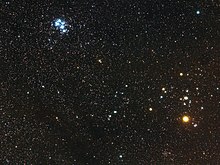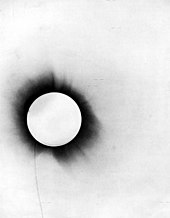Kappa Tauri
| Observation data Epoch J2000.0 Equinox | |
|---|---|
| Constellation | Taurus |
| Right ascension | 04h 25m 22.16505s[1] |
| Declination | +22° 17′ 37.9375″[1] |
| Apparent magnitude (V) | +4.22[2] |
| Right ascension | 04h 25m 25.01518s[1] |
| Declination | +22° 11′ 59.9876″[1] |
| Apparent magnitude (V) | +5.24[2] |
| Characteristics | |
| Spectral type | A7IV-V[3] |
| U−B color index | +0.12[2] |
| B−V color index | +0.14[2] |
| Spectral type | A7V |
| U−B color index | +0.09[2] |
| B−V color index | +0.17[2] |
| Astrometry | |
| Radial velocity (Rv) | +37.30[4] km/s |
| Proper motion ( | RA: +105.10[1] mas/yr Dec.: −45.04[1] mas/yr |
| Parallax ( | 21.19 ± 0.21 mas[1] |
| Distance | 154 ± 2 ly (47.2 ± 0.5 pc) |
| Absolute magnitude (MV) | +0.96[5] |
| Radial velocity (Rv) | +32.00[6] km/s |
| Proper motion ( | RA: +111.97[1] mas/yr Dec.: −47.71[1] mas/yr |
| Parallax ( | 22.03 ± 0.35 mas[1] |
| Distance | 148 ± 2 ly (45.4 ± 0.7 pc) |
| Absolute magnitude (MV) | +2.18[5] |
| Details | |
| Radius | 2.60[7] R☉ |
| Luminosity | 33.6[8] L☉ |
| Temperature | 9,000[7] K |
| Rotational velocity (v sin i) | 94[9] km/s |
| Luminosity | 11.8[8] L☉ |
| Temperature | 7,400[8] K |
| Rotational velocity (v sin i) | 191[9] km/s |
| Other designations | |
| Database references | |
| SIMBAD | |
Kappa Tauri (
System[edit]

The system is dominated by a visual double star,
Between the two bright stars is a binary star made up of two 9th magnitude stars, Kappa Tauri C and Kappa Tauri D, which are 5.5 arcseconds from each other (as of 2013) and 175.1 arcseconds from
The bright pair are both members of the Hyades star cluster, while the fainter stars are all much more distant background stars.[13]
Test of General Relativity[edit]

Kappa Tauri was photographed during the solar eclipse of May 29, 1919 by the expedition of Arthur Eddington in Príncipe and others in Sobral, Brazil that confirmed Albert Einstein's prediction of the bending of light around the Sun from his general theory of relativity which he published in 1915.[14]
Naming[edit]
- With
φ ,υ andχ , it composed the Arabic were the Arabs' Al Kalbain, the Two Dogs.[15] According to the catalogue of stars in the Technical Memorandum 33-507 - A Reduced Star Catalog Containing 537 Named Stars, Al Kalbain were the title for five stars :φ as Alkalbain I,χ as Alkalbain II, these stars (κ 2 andκ 1) are Alkalbain III and Alkalbain IV, andυ as Alkalbain V.[16] - In Chinese,
天 街 (Tiān Jiē), meaning Celestial Street, refers to an asterism consisting ofκ 1 Tauri andω Tauri. Consequently,κ 1 Tauri itself is known as天 街 一 (Tiān Jiē yī, English: the First Star Star of Celestial Street.).[17]
References[edit]
- ^ a b c d e f g h i j van Leeuwen, F. (2007), "Validation of the new Hipparcos reduction", Astronomy and Astrophysics, 474 (2): 653–664, arXiv:0708.1752, Bibcode:2007A&A...474..653V, doi:10.1051/0004-6361:20078357, S2CID 18759600.
- ^ a b c d e f g h Mermilliod, J.-C. (1986), "Compilation of Eggen's UBV data, transformed to UBV (unpublished)", Catalogue of Eggen's UBV Data. SIMBAD, Bibcode:1986EgUBV........0M.
- ^ Cowley, A.; et al. (April 1969), "A study of the bright A stars. I. A catalogue of spectral classifications", Astronomical Journal, 74: 375–406, Bibcode:1969AJ.....74..375C, doi:10.1086/110819
- ^ Gontcharov, G. A. (November 2006), "Pulkovo Compilation of Radial Velocities for 35,495 Hipparcos stars in a common system", Astronomy Letters, 32 (11): 759–771, arXiv:1606.08053, Bibcode:2006AstL...32..759G, doi:10.1134/S1063773706110065, S2CID 119231169.
- ^ a b Eggen, Olin J. (July 1998), "The Age Range of Hyades Stars", The Astronomical Journal, 116 (1): 284–292, Bibcode:1998AJ....116..284E, doi:10.1086/300413.
- ^ Kharchenko, N. V.; et al. (2007), "Astrophysical supplements to the ASCC-2.5: Ia. Radial velocities of ˜55000 stars and mean radial velocities of 516 Galactic open clusters and associations", Astronomische Nachrichten, 328 (9): 889–896, arXiv:0705.0878, Bibcode:2007AN....328..889K, doi:10.1002/asna.200710776, S2CID 119323941.
- ^ a b c Rhee, Joseph H.; et al. (May 2007), "Characterization of Dusty Debris Disks: The IRAS and Hipparcos Catalogs", The Astrophysical Journal, 660 (2): 1556–1571, arXiv:astro-ph/0609555, Bibcode:2007ApJ...660.1556R, doi:10.1086/509912, S2CID 11879505.
- ^ a b c McDonald, I.; et al. (2012), "Fundamental Parameters and Infrared Excesses of Hipparcos Stars", Monthly Notices of the Royal Astronomical Society, 427 (1): 343–57, arXiv:1208.2037, Bibcode:2012MNRAS.427..343M, doi:10.1111/j.1365-2966.2012.21873.x, S2CID 118665352.
- ^ a b Royer, F.; et al. (February 2007), "Rotational velocities of A-type stars. III. Velocity distributions", Astronomy and Astrophysics, 463 (2): 671–682, arXiv:astro-ph/0610785, Bibcode:2007A&A...463..671R, doi:10.1051/0004-6361:20065224, S2CID 18475298.
- ^ "* kap01 Tau". SIMBAD. Centre de données astronomiques de Strasbourg. Retrieved 2015-11-05.
- ^ "* kap02 Tau". SIMBAD. Centre de données astronomiques de Strasbourg. Retrieved 2015-11-05.
- ^ Mason, B. D.; et al. (2014), "The Washington Visual Double Star Catalog", The Astronomical Journal, 122 (6): 3466–3471, Bibcode:2001AJ....122.3466M, doi:10.1086/323920, retrieved 2015-11-08
- ^ Horan, S. (November 1979), "A photometric survey of the Hyades for Delta Scuti variables", Astronomical Journal, 84: 1770–1774, Bibcode:1979AJ.....84.1770H, doi:10.1086/112607
- ^ Dyson, F.W.; Eddington, A.S.; Davidson, C.R. (1920). "A Determination of the Deflection of Light by the Sun's Gravitational Field, from Observations Made at the Solar eclipse of May 29, 1919". Phil. Trans. Roy. Soc. A. 220 (571–581): 291–333. Bibcode:1920RSPTA.220..291D. doi:10.1098/rsta.1920.0009.
- ^ Allen, Richard Hinckley (1899), Star-Names and Their Meanings, New York: G. E. Stechert, p. 413
- ^ Rhoads, Jack W. (November 15, 1971), Technical Memorandum 33-507-A Reduced Star Catalog Containing 537 Named Stars (PDF), Jet Propulsion Laboratory, California Institute of Technology.
- ^ (in Chinese) AEEA (Activities of Exhibition and Education in Astronomy)
天文 教育 資 訊網 2006年 5月 23日
